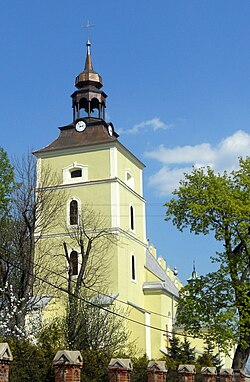Lelów
| Lelów | |
|---|---|
| Village | |

Saint Martin Church
|
|
| Coordinates: 50°40′57″N 19°37′31″E / 50.68250°N 19.62528°E | |
| Country |
|
| Voivodeship | Silesian |
| County | |
| Gmina | Lelów |
| Population | 2,127 |
Lelów [ˈlɛluf] (Yiddish: לעלוב - Lelov) is a village in , Silesian Voivodeship, in southern Poland. It is the seat of the gmina (administrative district) called Gmina Lelów. It lies on the Białka river, approximately 39 kilometres (24 mi) east of and 66 km (41 mi) north-east of the regional capital Katowice. In the Kingdom of Poland, Lelów was an important urban center of Lesser Poland, as a capital of a county which belonged to Kraków Voivodeship. The village has a population of 2,127.
In the early days of the Kingdom of Poland, a gord was established on the Białka river bank, in a swampy area, which gave protection from invaders. First documented mention about Lelów appeared in the year 1193, in a document issued by Pope Celestine III. In 1246, during the period known as Fragmentation of Poland (see Feudal fragmentation), Prince Konrad I of Masovia initiated construction of the town, in the location of the ancient gord. In the early 14th century Lelów, which by then was property of Bishops of Kraków, was captured by knights of Władysław I the Elbow-high. The town was manned by German and Czech troops, loyal to Bishop Jan Muskata (see also Rebellion of wójt Albert).
In the 14th century Lelów prospered, due to royal protection and privileges. Its population reached 1,200, and King Casimir III the Great built here a castle, and surrounded the town with a defensive wall. Lelów was located near the border with Czech-ruled Silesia, and as such, played an important role in the system of defence of Poland. In 1341 Lelów received Magdeburg rights from King Casimir, and became a county town in Kraków Voivodeship. In July 1345, during the Polish-Bohemian War, Czech units were defeated by the Poles and their Hungarian allies near Lelów. In the 15th and 16th centuries, Lelów remained one of the most important towns of Lesser Poland. It frequently burned, but managed to recover, and local cloth makers were famous across the country. In 1638 Lelów almost completely burned in a great fire, and further destruction was brought by the Swedish-Polish war, after which the town never recovered. Lelów was once again destroyed in the Great Northern War, after which its defensive wall was pulled down.
...
Wikipedia

